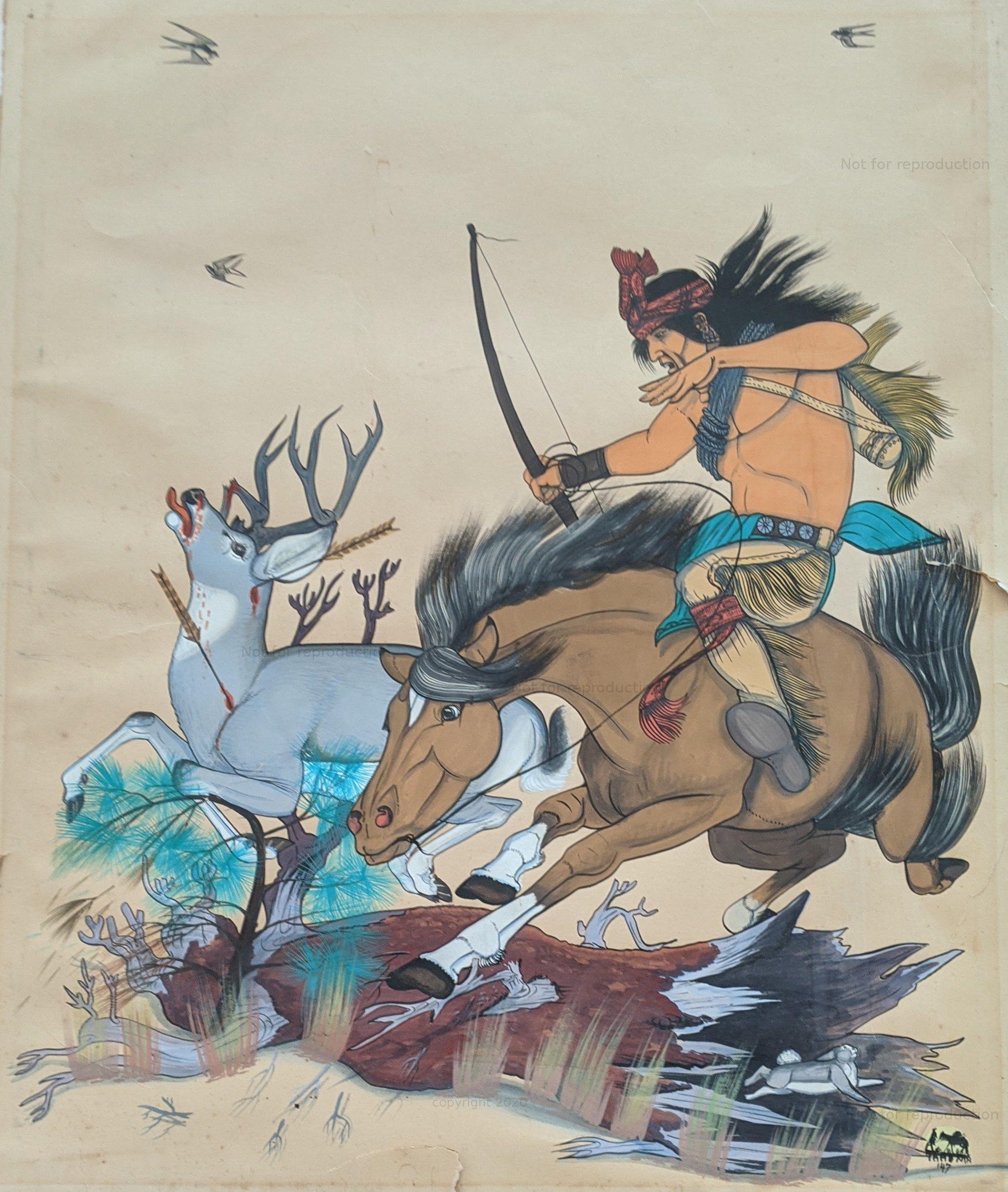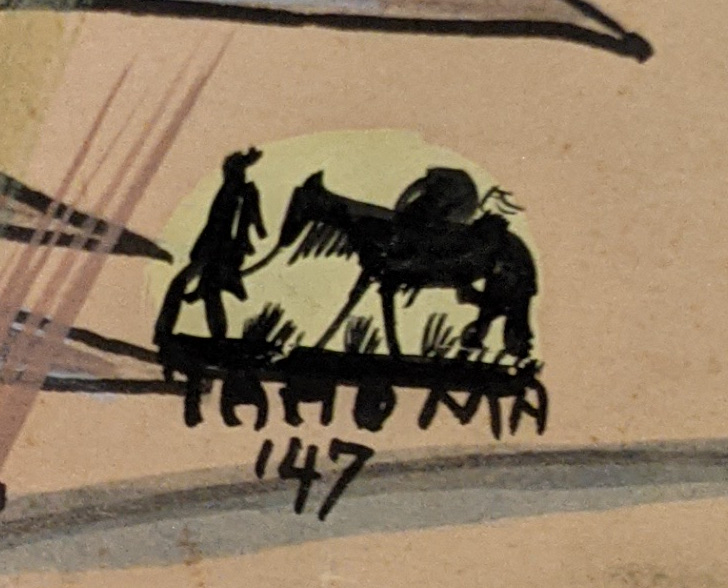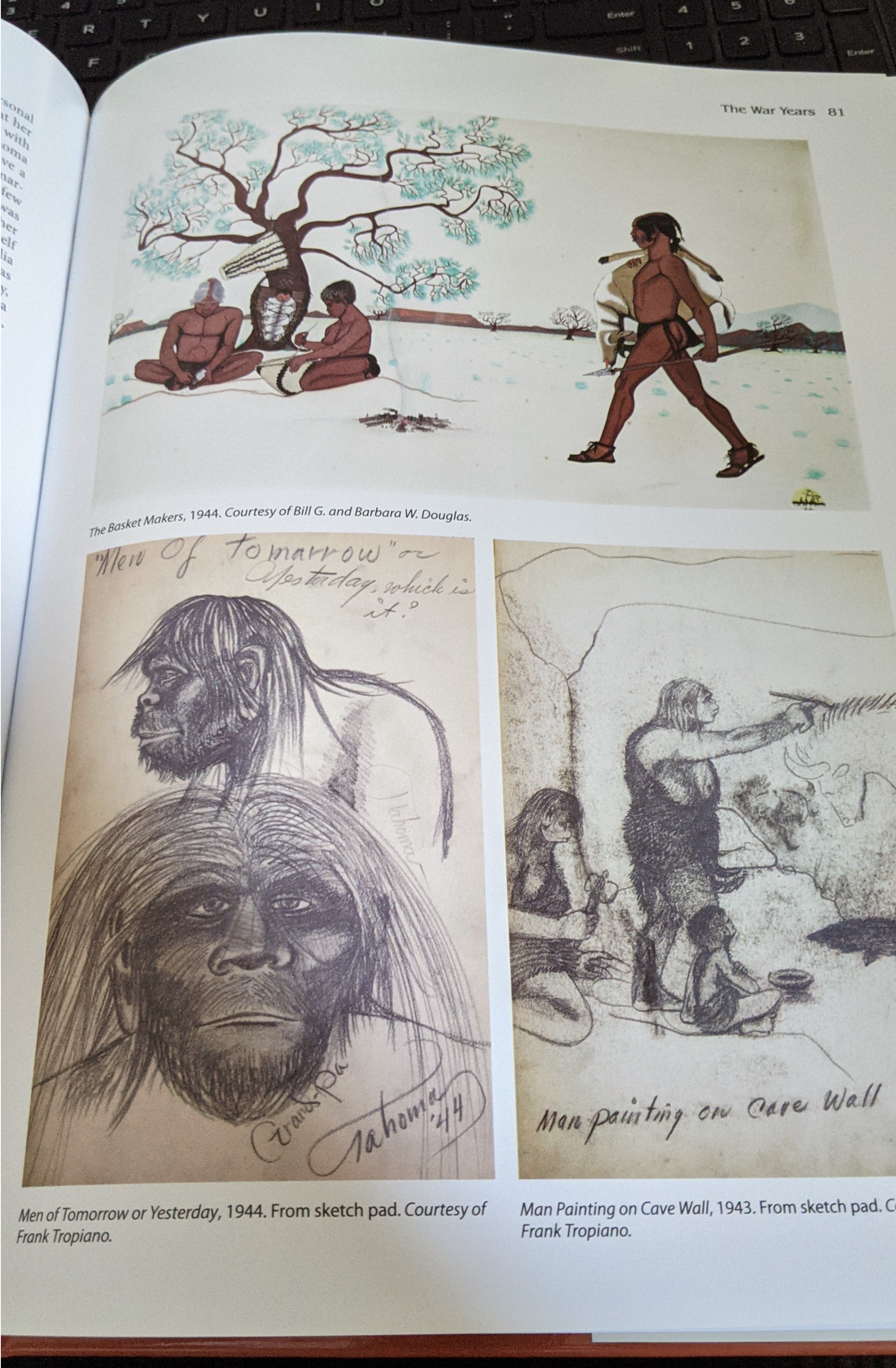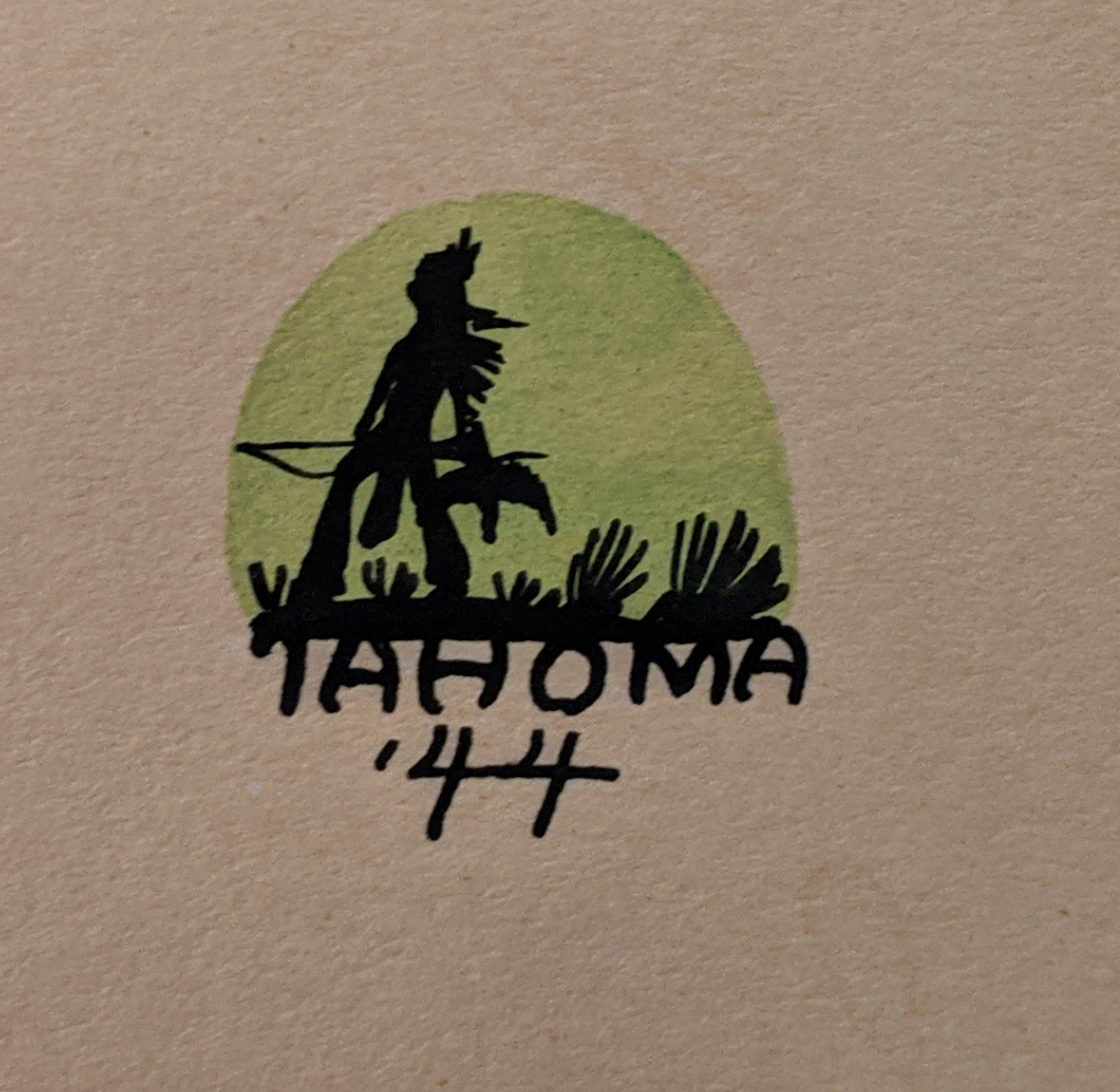Over the Hollow Log by Quincy Tahoma

Quincy Tahoma painted Over the Hollow Log in 1947. This painting shows an artist at the peak of his skills. Everything about this image is characteristic of the best Tahoma paintings. But why was he doing his best work in 1947?
In 1947 Tahoma was 30 years old. He was a famous artist in New Mexico, and he had achieved a measure of national success by winning a prize from the Philbrook Museum in 1946. But he was facing the first great challenge of his life as a consequence of his growing dependence on alcohol.
The reason Tahoma painted some of his best pieces in 1947 is because he was sober. The reason he was sober is that he was in prison. The reason he was in prison is because he was accused of rape, and the story reveals something about Tahoma's character, and about how the criminal justice system treated Native Americans in the mid 20th century.
Here's how Charnell Havens and Vera Marie Badertscher summarized the incident that landed Tahoma in prison in 1947 in Quincy Tahoma: The Life and Legacy of a Navajo Artist.
On New Year's Eve 1946, he had many successes to celebrate. He liked to socialize and his celebrations often involved too much drinking. He would sober up – sometimes in jail – and then get back to life. This time, however, the party got out of control…
On New Year's Day, a Wednesday, Mrs. Hobbs complained to the police that her daughter was missing. When the sheriff, aided by the state patrol, located the girl in Albequerque on that same day, she "told her story" according to the Santa Fe newspaper. She said a Navajo artist named Quincy Tahoma had offered her whiskey and raped her. The police quickly located Tahoma and held him in the Santa Fe jail until court convened on Friday, January 3…
Quincy Tahoma stood alone in the courtroom, probably not feeling well after the New Year's Eve celebration, and someone in the court or the District Attorney's office advised that he could plead guilty to a lesser plea. No defense attorney appears in the court paperwork so it is doubtful that anyone explained his options to him. No one suggested that if he thought the charges were unfair, he could plead not guilty. No transcript of witnesses appears, and the trial did not take long.
Tahoma was accused of raping a 16 year old girl named Vonnie Hobbs who had been out with him on New Year's Eve. He pled guilty and received a sentence of two to five years. His signature appears on none of the documents related to the case.
But prison was not so bad for Tahoma. In fact, if we judge that period of his life based on his artwork, it was the best period of his life. Tahoma was a famous prisoner, and he was well known to the warden and the guards. The guards purchased supplies for him, and he was able to paint every day. Since painting was all he cared about, he was not much bothered by being in prison.
He gave some paintings to the warden and the guards for additional privileges. Other paintings were taken out of prison and sold by various friends. Over the Hollow Log is almost certainly a painting that Tahoma produced while in prison.
Tahoma's work outside prison was becoming quite inconsistent. His drinking was lending some paintings an unfinished or sketchy quality. None of his prison work reflects this drop in quality.
The painting is one of Tahoma's best because it reflects his mastery of single page storytelling. It depicts a Native American man wearing a concho belt shooting a second arrow into a buck, while his horse and the buck leap a rotting log. The deer breathes its last breath while a scared rabbit runs out of the log. In the cartouche we can see that the hunter has managed to bring down the deer, as he has tied his kill to the back of his mount.

So much of this image is Quincy Tahoma flexing the techniques he had mastered by 1947. The background is plain, unpainted paper, but the scene is framed by three birds in the sky. The composition and drama of the scene reflects elements that were palatable to him, and were easy to sell to tourists. The horse and deer are painted using a mixture of painting and inking techniques that are still so evocative today. The image almost looks like an illustration from a comic book or pulp novel. The small animal running away appears in so many Tahoma paintings. One of his most oft repeated subjects was a horse being scared by a skunk or other small animal. The dress of the hunter is also typical of Tahoma, with the characteristic flourescent blue-green loin cloth that appears in almost every Tahoma depiction of Native Americans in traditional dress.
The depiction of the tree in this painting is remarkably life-like. Tahoma preferred to paint stylized plants and trees. His depiction of a realistic tree in this painting is one thing that makes it stand out among his other works.
Tahoma lived many lives. After the war he had an increasingly difficult time keeping his lives separate. In 1947 his double lives continued. He was simultaneously a prisoner whose basic freedoms had been taken away, and a successful artist creating the best work of his life.
Painted during his time in prison, Over the Hollow Log is one of the best pieces created by Quincy Tahoma.
2020 Changed Me
I have so much to say about 2020 that I'm not quite sure how to say it. The year was simultaneously fantastic and terrible for me and my family. A lot of good things happened to me to 2020, and I was able to avoid a lot of the worst things that were happening around the country.
I'm having a hard time talking about 2020 because, among so much suffering, my family actually did pretty well. Nobody in my family died of COVID. My kids are doing well with remote learning. My wife and I have begun volunteering in our community, and really getting to know our community. I even got a promotion at work.
I want to talk about all of this, but it feels like gloating. The pandemic is not over yet. There are so many people still suffering so much due to the negligence, stupidity, and incompetence of our elected Republican leaders.
So what can I say?
I can say that 2020 changed me. It changed me in a lot of ways.
One of the odd, quirky traits that I developed during lockdown is a passionate interest in 20th century Navajo artists, especially those taught at the Santa Fe Indian School by Dorothy Dunn. This includes people like Harrison Begay, Woody Crumbo, and Allan Houser. But for me, the best among them was Quincy Tahoma.
I don't know how this interest developed, but it's so unusual that it's the one thing I feel comfortable writing about at this point. Which is a long winded way of saying that, although I'm no expert, I'm going to write about some of the art that I've fallen in love with in the past year.
The Archer by Quincy Tahoma

Quincy Tahoma painted The Archer in 1944. He was 27 years old, but the government thought he was 24, and he was happy to go along with the deception. He liked being the young Navajo artist whose talent couldn't be kept on the reservation. But he was living multiple lives, and that became obvious in 1944.
Tahoma wanted to fight in the war, but a childhood injury that severely limited the use of his left arm prevented him from doing so. As a native speaker of the Navajo language, the government thought he could be useful in intelligence work, and called him up in 1943, but they soon sent him home for reasons that remain unclear. So in 1944 he disseminated several conflicting stories about his war service.
Tahoma was accustomed to leading a double life. As a student at the Santa Fe Indian School he always had one foot in his native Navajo culture, and one foot in white America. After his father died, he was raised partly by an aunt, and partly by several boarding schools that taught Native Americans to integrate into white society. He found art through an incredibly influential teacher named Dorothy Dunn. As an artist, Tahoma relied on white America for his income. Tourists flocked to New Mexico to see and experience Native American culture while they could. Tahoma was happy to paint the pictures that they wanted to see, pictures of a proud native heritage that mixed cultures and drew on all of his life experience.
In 1944 he was the darling of the New Mexico art scene. He was featured in a short film, and he worked for the Museum of New Mexico, painting scenes of early humans.

The Archer shows off Tahoma's confidence, but it also reveals his immaturity. It shows a confident, clear-eyed hunter who bags his prey, as we can see in the cartouche. But the composition is flat and one dimensional, lacking the drama of his best paintings. Also, Tahoma mistakes the musculature of the archer's right knee.
Still, it reveals some of the techniques that made Tahoma famous. The sequential art in the cartouche is exquisite. The mixture of inking and painting techniques lends the painting an illustrative quality. The bird in the upper left defines the frame as in so many Tahomas. And the characteristic blue-green of the archer's loin cloth is still as brilliant as the day it was painted.

The Archer isn't the best painting by Quincy Tahoma, but it displays a blossoming talent. It reveals a young artist who has yet to face alcoholism, and who hasn't yet reckoned with the consequences of his double lives.
Drowning in 2020

What a year.
I remember the year we had our second child, Leta. That was a difficult year. Having a two year old and a newborn in the house was not easy. Ultimately, I failed that test in many ways. I don't think I failed as a father, but I did a lot of damage to myself in order to get through the year.
I changed jobs shortly after Leta was born, but I was never able to succeed at that job. The anxiety from the birth and changing jobs just took over my life. I developed ulcers and other health issues that took me years to beat.
This year was harder. I know I'm not alone when I say that I felt like I was drowning. With the virus ravaging the country and a president who insisted on calling it a hoax or downplaying its effects, it felt like the world was closing in on me.
And that's what produced this album. I wrote it in the first few months of lockdown, when there was much false hope, but no real hope for an end to the unfolding tragedy.
This music differs from most of my other music in many ways. For one, there's only one collaborator on it, unlike my other recent work which has featured many other collaborators. Also, it's much darker. It's a bleak, synthesized hellscape that chokes off the light. It's violent and dark and lonely.
Just like 2020.
I'm proud to say that I didn't fail this year. As the world was melting down around me, I didn't drown. I swam. I was promoted at my job. I took a leadership position in my community. I volunteered at the local library. I made things. And I didn't come out with any new health problems.
But still, the year mostly felt like I was drowning.
Thanks for listening!
Jazz from California
Jazz isn't necessarily the first thing you think of, when you think of California. You might think of surfing, Dick Dale, the Golden Gate Bridge, or Hollywood. But California has a rich history in Jazz.
Don't forget that California made Benny Goodman a star, and made swing music into popular music. After the war, dozens of amazing soloists were made in California, including Dexter Gordon, Lester Young, Art Pepper, and Eric Dolphy. Household names like Dick Brubeck, Stan Getz, and Cal Tjader all started their careers in California.
I put together this playlist to celebrate the great jazzers from CA. Listen to the end to catch some more modern artists who stand tall with the rest of these greats.
